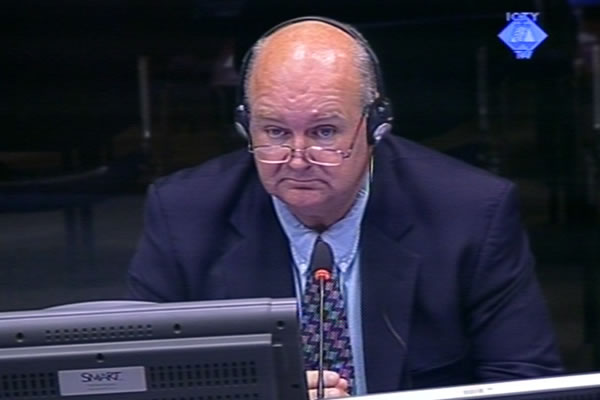Home
‘ARSONISM’ IN SARAJEVO
In his evidence at the trial of Ratko Mladic, John Jordan spoke about the efforts of Sarajevo firemen and foreign volunteers to put ‘fires and arsonism’ under control and put out hundreds of fires caused by the shelling of Sarajevo. The defense put it to the witness that the international fire brigade who were armed did not protect their Sarajevo colleagues but in fact endanger both them and civilians
 John Jordan, witness at the Ratko Mladic trial
John Jordan, witness at the Ratko Mladic trial The entire evidence of a witness testifying under the pseudonym RM 147 was heard in closed session. The trial of the former VRS Main Staff commander continued with the testimony of John Jordan, former US marine and member of the independent fire brigade (GOFRS, Global Operation Fire Rescue Services) that was tasked to put out fires on both sides of the front line in Sarajevo. GOFRS worked under the UN auspices.
The prosecution tendered into evidence Jordan’s statement and several video recordings that the witness handed to the OTP in 2006. CNN and ABC TV crews recorded the efforts of the international and Sarajevo firemen to place under control ‘large scale fires and arsonism’ in Sarajevo.
Jordan was in Sarajevo from November 1992 to October 1995. During that time, he helped extinguish 200 to 300 fires and helped hundreds of injured civilians. Jordan and the members of his brigade were shot at when they fought to put out fires, to protect Sarajevo firemen or to help injured civilians. In most of cases, the shots came from locations under the control of Bosnian Serbs. On one occasion, the international firemen were hit by shrapnel of a shell fired by the BH Army troops.
Jordan saw dug in VRS mortars on the hill slopes overlooking Sarajevo; the mortars were ready to fire. As he answered questions asked by Mladic’s defense counsel Dragan Ivetic, Jordan confirmed that he never saw mortars firing as he passed by. He did see and feel their activity while he was in the city, Jordan added.
The defense counsel tried to discredit the witness by putting it to him that he had been a ‘mercenary’ who took part in secret missions outside the USA. As Jordan said, he came to Sarajevo to serve as a fireman, but added that he and other members of his team had been armed. Ivetic put it to him that armed firemen were a legitimate target, that they provoked the warring sides to open fire and thus endangered the unarmed firemen and civilians. Jordan countered the claims by saying that until their arrival, one in five firemen had been killed or injured by gunfire as they were putting out fires. Their Sarajevo colleagues ‘never lost a single man’ after his brigade took them under their protection, Jordan claimed.
The defense lawyer also put it to witness that the BH Army troops had portable mortars, easy to ‘assemble and dismantle’; it was standard military procedure to ‘respond to fire by firing at the location from which it came’. Jordan confirmed he saw an 82-mm mortar in the Kosevo hospital which was active. He also confirmed that this type of mortar was inaccurate and could in fact hit the territory held by the troops that fired from it. The targets were undershot ‘more often than it was desirable’, Jordan said. This topic roused the interest of the accused who exchanged several notes and smiles with his defense counsel Saljic. The accused also asked through his defense counsel for permission to speak and read out ‘30 words about the accuracy of smart technology’ that was not used in Sarajevo. The Trial Chamber didn’t give him the floor.
In the re-examination, the witness said that though he was in the city every week he saw a portable mortar firing only once. There were more weapons outside of the city than inside and the fire was opened ‘from the hills’: the positions held by the Bosnian Serbs, he added. The BH Army responded from ‘the valley’: their positions were in the city, Jordan explained.
Ratko Mladic’s trial for genocide and other crimes in Bosnia and Herzegovina continues tomorrow with the evidence of Fejzija Hadzic. On 5 August 1992, Hadzic survived the massacre in Jalasacko Polje in Kalinovik municipality.
Linked Reports
- Case : Mladic
- 2012-08-27 MLADIC WANTED TO ‘ROLL OUT THE MINDS’ OF THE PEOPLE IN SARAJEVO
- 2012-08-24 MLADIC APOLOGIZES
- 2012-08-23 LORD CARRINGTON’S VAIN HOPES
- 2012-08-29 WITNESSES SURVIVED EXECUTIONS BY A MIRACLE
- 2012-08-30 EVIDENCE ON EXECUTION IN BILJANI COMPLETED
- 2012-08-31 MLADIC REMOVED FROM COURTROOM
